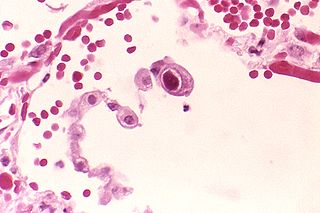
Cytomegalovirus (CMV) is a genus of viruses in the order Herpesvirales, in the family Herpesviridae, in the subfamily Betaherpesvirinae. Humans and other primates serve as natural hosts. The 11 species in this genus include human betaherpesvirus 5, which is the species that infects humans. Diseases associated with HHV-5 include mononucleosis and pneumonia, and congenital CMV in infants can lead to deafness and ambulatory problems.
Virus classification is the process of naming viruses and placing them into a taxonomic system similar to the classification systems used for cellular organisms.

The International Committee on Taxonomy of Viruses (ICTV) authorizes and organizes the taxonomic classification of and the nomenclature for viruses. The ICTV develops a universal taxonomic scheme for viruses, and thus has the means to appropriately describe, name, and classify every virus taxon. The members of the International Committee on Taxonomy of Viruses are considered expert virologists. The ICTV was formed from and is governed by the Virology Division of the International Union of Microbiological Societies. Detailed work, such as identifying new taxa and delimiting the boundaries of species, genera, families, etc. typically is performed by study groups of experts in the families.

Betaherpesvirinae is a subfamily of viruses in the order Herpesvirales and in the family Herpesviridae. Mammals serve as natural hosts. There are 26 species in this subfamily, divided among 5 genera. Diseases associated with this subfamily include: human cytomegalovirus (HHV-5): congenital CMV infection; HHV-6: 'sixth disease' ; HHV-7: symptoms analogous to the 'sixth disease'.
Muromegalovirus is a genus of viruses in the order Herpesvirales, in the family Herpesviridae, in the subfamily Betaherpesvirinae. Rodents serve as natural hosts. There are three species in this genus. Diseases associated with this genus include: infected peritoneal macrophages, dendritic cells (DC) and hepatocytes, inducing significant pathology in both the spleen and the liver. Murid viruses Murid betaherpesvirus 1 (MuHV-1) and Murid betaherpesvirus 2 (MuHV-2), previously defined as mouse cytomegalovirus (MCMV) and rat cytomegalovirus (RCMV), belong to this genus.
Testudinid alphaherpesvirus 3 (TeHV-3) is a species of virus in the family Herpesviridae.
Aotine betaherpesvirus 1 (AoHV-1) is a species of virus in the genus Cytomegalovirus, subfamily Betaherpesvirinae, family Herpesviridae, and order Herpesvirales.
Cebine betaherpesvirus 1 (CbHV-1) is a species of virus in the genus Cytomegalovirus, subfamily Betaherpesvirinae, family Herpesviridae, and order Herpesvirales.
Cercopithecine betaherpesvirus 5 (CeHV-5) is a species of virus in the genus Cytomegalovirus, subfamily Betaherpesvirinae, family Herpesviridae, and order Herpesvirales.
Macacine betaherpesvirus 8 (McHV-8) is a species of virus in the genus Cytomegalovirus, subfamily Betaherpesvirinae, family Herpesviridae, and order Herpesvirales.
Mandrilline betaherpesvirus 1 (MleuCMV) is a species of virus in the family Herpesviridae.
Panine betaherpesvirus 2 (PnHV-2) is a species of virus in the genus Cytomegalovirus, subfamily Betaherpesvirinae, family Herpesviridae, and order Herpesvirales.
Papiine betaherpesvirus 3 (PaHV-3) is a species of virus in the genus Cytomegalovirus, subfamily Betaherpesvirinae, family Herpesviridae, and order Herpesvirales.
Cytomegalovirus papiinebeta4, formerly Papiine betaherpesvirus 4 (PaHV-4), is a species of virus in the genus Cytomegalovirus, subfamily Betaherpesvirinae, family Herpesviridae, and order Herpesvirales.
Saimiriine betaherpesvirus 4 (SaHV-4) is a species of virus in the genus Cytomegalovirus, subfamily Betaherpesvirinae, family Herpesviridae, and order Herpesvirales.
Murid betaherpesvirus 3 (MuHV-3) is a species of virus in the family Herpesviridae.
Callitrichine gammaherpesvirus 3 (CalHV-3) is a species of virus that infects marmosets. It is in the genus Lymphocryptovirus, subfamily Gammaherpesvirinae, family Herpesviridae, and order Herpesvirales.
Suid gammaherpesvirus 3 (SuHV-3) is a species of virus in the genus Macavirus, subfamily Gammaherpesvirinae, family Herpesviridae, and order Herpesvirales.
Phocid gammaherpesvirus 3 (PhHV-3) is a species of virus in the family Herpesviridae.
Ateline gammaherpesvirus 3 (AtHV-3) is a species of virus in the genus Rhadinovirus, subfamily Gammaherpesvirinae, family Herpesviridae, and order Herpesvirales.

